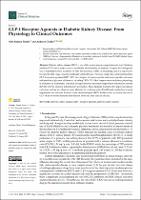GLP-1 Receptor Agonists in Diabetic Kidney Disease: From Physiology to Clinical Outcomes
Date
2021-09Permanent link
https://hdl.handle.net/11351/7433DOI
10.3390/jcm10173955
ISSN
2077-0383
WOS
000694268900001
PMID
34501404
Abstract
Diabetic kidney disease (DKD) is one of the most common complications in type 2 diabetes mellitus (T2D) and a major cause of morbidity and mortality in diabetes. Despite the widespread use of nephroprotective treatment of T2D, the incidence of DKD is increasing, and it is expected to become the fifth cause of death worldwide within 20 years. Previous studies have demonstrated that GLP-1 receptor agonists (GLP-1 RA) have improved macrovascular and microvascular outcomes independent of glycemic differences, including DKD. GLP-1Ras’ improvement on kidney physiology is mediated by natriuresis, reduction in hyperfiltration and renin-angiotensin-aldosterone system (RAAS) activity and anti-inflammatory properties. These findings translate into improved clinical outcomes such as an enhanced urine albumin-to-creatinine ratio (UACR) and a reduction in renal impairment and the need for renal replacement therapies (RRT). In this article, we review the role of GLP-1RAs on the mechanisms and effect in DKD and their clinical efficacy.
Keywords
GLP-1 receptor agonists; Diabetic kidney diseaseBibliographic citation
Rojano Toimil A, Ciudin A. GLP-1 Receptor Agonists in Diabetic Kidney Disease: From Physiology to Clinical Outcomes. J Clin Med. 2021 Sep;10(17):3955.
Audience
Professionals
This item appears in following collections
- HVH - Articles científics [4476]
- VHIR - Articles científics [1751]
The following license files are associated with this item:

 Private area
Private area Contact Us
Contact Us








